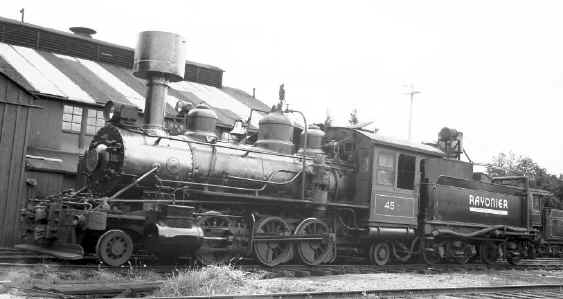Rayonier #45: Rod Locomotive |
|
Logging Railroads date back to the 1870's. By the turn of
the century a variety of geared logging locomotives were available to
loggers to bring in logs to the mills.
Geared power worked well in the early years because the logging
sites were relatively near the mills and the slow speed of the geared
engines was not a problem. The
rough and twisting track required special locomotives and geared power
worked well. As the cutting areas moved further back into the woods and
away from the mills, the geared engines with their slow speed began to
delay production and a solution was needed. In stepped Baldwin in 1896 and began marketing a
selection of small-drivered 2-6-2 (Prairie) type locomotives to loggers.
The small drivers were necessary to handle the steep grades found
on loggers tracks. The
rod-type 2-6-2 had a much greater speed which enabled it to pick up the
log loads that the geared power had brought in from the steep twisting
track that was at the cutting site and move the loads to the mill on the
better built track that led from camp to mill. By 1900 the Polson Brothers of Hoquiam, WA had been
cutting timber in that region for a number of years. In the early years
the geared Shays and Climax engines used by Polson Brothers Logging Co.
did a good job of keeping the mill supplied with logs. By 1900 however,
the cutting areas had moved far enough into the woods that a faster
locomotive was needed to bring the logs from the log camp to the mill.
Polson Brothers took delivery of #45 in January 1906. She was built as a wood burner with tall racks on her tender
to hold several cords of wood. Her
small 44" drivers gave her good traction on the grades but also
allowed her to travel twice the speed that the geared power could
operate. In the 1920's Polson Brothers converted #45 to burn oil to
reduce the danger of her starting trackside fires that would burn the
very timber Polson was trying to harvest. In the 1930's when her smoke box was wearing thin the
master mechanic at the shops at Railroad Camp used a section of an old
donkey boiler to make a new smoke box for #45.
The unique donkey boiler smoke box is still on #45 today. In 1945
Polson Brothers sold their holdings and railroad to Rayonier Inc.
By this time, larger rod-type 2-8-2 and 2-6-6-2 mallet engines
had replaced little #45 on the mainline log-haul.
#45 continued in service around Railroad Camp and in work
train service until she was retired in 1960 and donated to the City of
Hoquiam and put on display at the Polson Museum at Hoquium, WA. By 1998
#45 was deteriorating badly from the salt air at her display site. The
City of Hoquiam donated #45 to the Mount Rainier Scenic RR in 1998 and
she was shipped to the shops at Mineral, WA.
Due to her small size and badly deteriorated condition, present
plans call for her to be cosmetically restored and preserved as a
testament to the loggers use of early rod-type logging locomotives. Specifications: This
44 ton Prairie was built by the Baldwin Locomotive Works in
Philadelphia, PA for the Polson Logging Company of Hoquiam, WA:
Ownership
History:
Photographs and information courtesy of Martin E. Hansen |
| HOME | ||||
| Cams/Plating |
